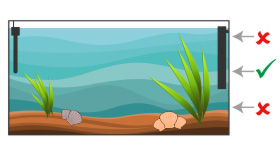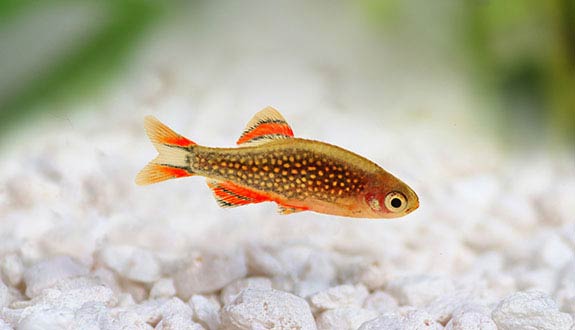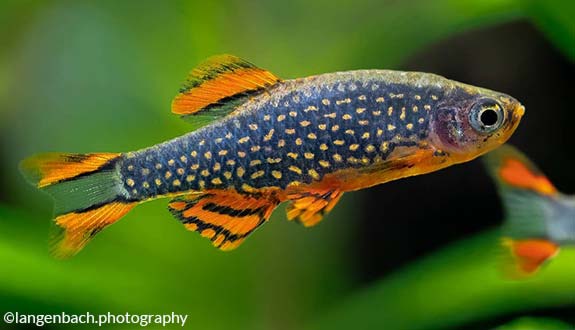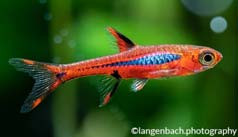

Alternative species (click on the thumbnail to see the card)
Names
Scientific name
Danio margaritatus
Celestichthys margaritatus
Common name
Galaxy rasbora
Celestial pearl danio
Microrasbora Galaxy
Microrasbora sp. 'Galaxy'
Origin

Origin: Thailand
Biotope: Asian
Dimorphism

The male has red flippers with black stripes, the female has yellow and transparent flippers.
Group

Cyprinidae
Volume

60 L / 13 imp gal / 16 US gal
Parameters

T°: 22 to 25°C or 72 to 77°F
pH: 7 to 8
Hardness: 5 to 10°dGH
Difficulty

Average
Size

2 to 3cm (0.8 to 1.2")
Longevity

2 to 4 years
Living zone

Middle
Individuals

10
Food
How to feed the Galaxy rasbora?
Food
How to feed the Galaxy rasbora?
In its natural environment, the Galaxy rasbora is insectivorous. Nevertheless, fish living in aquariums have become omnivorous.
The Galaxy rasbora is particularly small. It is therefore important to feed it with food adapted to the size of its micro mouth!
It can be fed with commercially available food such as flakes or pellets, which you will chop finely. You will supplement this basic food with live or frozen food (algae, zooplankton, micro worms, insect larvae).
Little tip > It's not very difficult to discern the favourite meal of these fish: when you put live food, the Danios will throw themselves on it greedily! So don't hesitate to offer them this kind of meal regularly.
Behavior
What kind of behavior does the Galaxy rasbora have?
Behavior
What kind of behavior does the Galaxy rasbora have?
It is a particularly shy and fearful fish. It tends to spend its time hidden in the vegetation of your aquarium. Be careful not to approach your tank too abruptly as it will immediately flee. The only exception is at feeding time, when you will observe the Galaxy rasbora coming out of its hiding places to feed.
To remedy this extremely reserved character, the only solution is to reassure it: specific aquarium if possible, presence of many plants, cohabitation with many congeners (the more they will be numerous and the less shy they will be).
If it is kept in good conditions, this fish will come out of its hiding places regularly, even ending up not hiding at all in your presence. In rare cases, the male may deploy his fins to intimidate another male. This is safe and without risk of injury. Note that the hierarchy of the group sets up very quickly.
When the female is pregnant, she may be chased by several males. Don't worry about that either, it's safe for the protagonists. You can provide dense plant cover to allow the female to hide easily.
Cohabitation
Who can live with the Galaxy rasbora?
Cohabitation
Who can live with the Galaxy rasbora?
The first of the rules to be respected concerning the cohabitation of the MGalaxy rasbora is the presence of many of its congeners. A minimum of 10 individuals is recommended, but the more the better. They will evolve in a school and a hierarchy will be established within it.
As for the other species of fish, they will simply ignore them and only look after their fellow fish.
However, due to its very shy nature and small size, the Galaxy rasbora can be intimidated by fish larger than itself: almost all fish. This is why it is preferable not to add other species living in the same area as it (middle of the aquarium) such as Barbus for example.
On the other hand, you can associate him Corydoras or Otocinclus (be careful with the water parameters) but also shrimps of the genus Neocaridina Davidii (like the Red Cherry for example).
Breeding
How to breed the Galaxy rasbora?
Breeding
How to breed the Galaxy rasbora?
The reproduction of Danios Margaritatus is possible if you respect some rules.
First of all, examine the sexual dimorphism as it will be useful. The male has red fins with black stripes. The female, on the other hand, is rounder and will have flippers that are yellow and transparent.
Plan a small aquarium of about thirty litres specially dedicated to breeding and rearing. The eggs and tiny fry will all be eaten in the presence of their parents or other fish. In the breeding aquarium, the presence of fine-leaved plants such as Java moss is indispensable. Recommended water parameters for breeding are: temperature at 24°C (75°f), pH at 6, hardness at 5°dGH.
Introduce in this aquarium several couples, with well rounded females. Stimulate spawning by feeding them live prey. You will observe the male parading around with his fins extended to impress the female. He will chase her down and eventually bring her to an egg-laying site that he deems appropriate, such as a plant.
The female then expels about 30 ova that are slightly sticky on the leaves. They will then be fertilized by the male. If this has not yet been done, there is still time to retrieve the eggs and place them in a breeding aquarium.
Once the eggs have been laid, you can remove the parents. The eggs will take 3 to 4 days to hatch and the free swimming of the fry will take place on the same day. The Galaxy rasbora's beautiful colouring comes after about 12 weeks.
Fry food: only micro food such as micro worms, micro plankton, infusoria, artemia nauplias...
Its aquarium
Which aquarium for the Galaxy rasbora?
Its aquarium
Which aquarium for the Galaxy rasbora?
The Danio Margaritatus needs water that resembles as much as possible that of its natural environment, i.e. basic and slightly hard. Be careful when changing water: they should not be done with too sudden movements but rather calmly, without rushing, so as not to panic your little companions. Moreover, the parameters of the new water should be as close as possible to those of the aquarium, especially for the temperature. You can leave on a water change of 15 to 20% every 2 weeks.
This species does not like strong currents and swirls. If possible, opt instead for gentle filtration (sponge filter for example).
The Microrasbora galaxy likes a very planted habitat because it is very shy. For example, plant species such as Egeria Densa, Cryptocoryne, Java moss, duckweed, etc.
Pay special attention to the location of your aquarium. Indeed, the tank of this very fearful fish (absolute vigilance) should not be placed in busy or agitated places such as corridors, kitchens or children's rooms. Instead, prefer calm places without too much traffic: this will reduce the stress on the fish and will encourage its confidence in its environment.
Good To know
Find all additional information!
Good To know
Find all additional information!

The Microrasbora galaxy fears heat, so make sure to keep it below 25°C even during the summer.
It was only discovered in 2006!
Yours photos!

By Encyclo-Caro

By Encyclo-Caro

By Encyclo-Caro

By Encyclo-Caro
Comments
Sort by:
Please login to post comments


